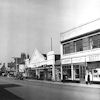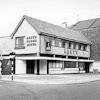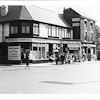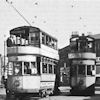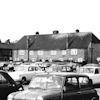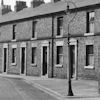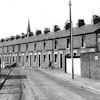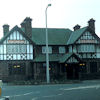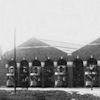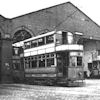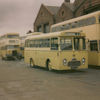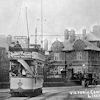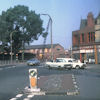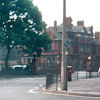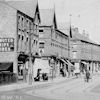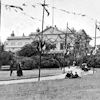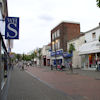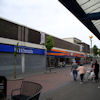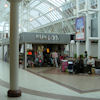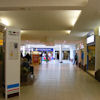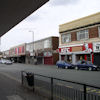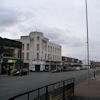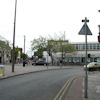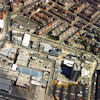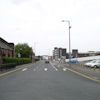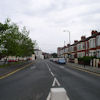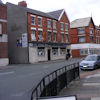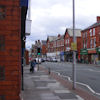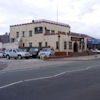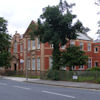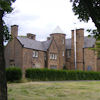Liscard
''Liscard' - Celtic or British "Lis" or "Llys" (Welsh) - "Fort" or "Manor House" - "Fort On the Height".
In the late 19th Century the old township of Liscard covered a large area and included a common, meadows and pasture land. At one time the village was approached from Wallasey Village along Wallasey Road (then called 'Wallasey And Liscard Road') - through a gate at the boundary of the township which led on to Liscard Common, around which houses sprawled. In 1910, following a Charter of Incorporation, Liscard township along with the townships of Wallasey Village and Poulton-cum-Seacombe, became the Borough of Wallasey. Three years later it became a County Borough.
Due to improvements with the ferry services between New Brighton, Seacombe and Egremont, Wallasey became quite popular with people working in Liverpool but wishing to live in more pleasant surroundings. Liscard, by 1900, was already becoming built-up, with a mixture of roads and terraced houses and large houses belonging to affluent merchants whose businesses were in Liverpool.
 During the 1960's Liscard was scheduled for redevelopment to provide a modern shopping centre for the Borough. The redevelopment necessitated the demolishing of rows of houses and the relocation of Marymount Convent. The Convent was built in 1878 and was situated on the corner of St. Albans Road and Mill Lane and then moved to Love Lane. The school was originally found by the Holy Family of Bordeaux as an independent Catholic Primary School.
During the 1960's Liscard was scheduled for redevelopment to provide a modern shopping centre for the Borough. The redevelopment necessitated the demolishing of rows of houses and the relocation of Marymount Convent. The Convent was built in 1878 and was situated on the corner of St. Albans Road and Mill Lane and then moved to Love Lane. The school was originally found by the Holy Family of Bordeaux as an independent Catholic Primary School.
Work began in May 1968 to provide a wider range of modern shops than was available before, all fronting on to a traffic free precinct. A large car park was also provided. The scheme is dominated by Liscard House and Dominick House. The latter was completed in 1970. In 1979 the one-way traffic light system was introduced. This then allowed part of Liscard Road to be cut off to traffic, thus completing the conversion of the Liscard Shopping area into a pedestrian precinct.
Liscard town centre looking towards Seaview Road, 1973
|
Liscard town centre looking towards Seaview Road, 1961
|
||
View of Liscard town centre, 1961
|
View looking towards the Boot Inn, Wallasey Road, 1962
|
||
Tower Hotel, Mill Lane, 1963 |
'Castle Hotel' pub on the corner of Wallasey Road & St.Albans Road, 1962
|
||
Two trams pass through Liscard, 1933 |
Rossett Place, 1966. Demolished to make way for the town centre
|
||
St.Albans Terrace, 1962
|
St.Albans Terrace, 1965. Demolished to make way for the town centre
|
||
Boot Inn, Wallasey Road. c1903
|
Boot In, Wallasey Road, 1990's
|
||
Brownies at Liscard Car Park, 1974 |
Liscard Roundabout, 1970s.
|
 The Monkey House, built in 1904, was a pagoda-like shelter house with glass windows, which was sited on a small island in the centre of the cross roads,opposite what was the Bank Of Liverpool (which opened on 22nd August 1908) which later became Martin's Bank before becoming Barclays Bank. Inside were wooden seats where folk would gather to chat and look out through the windows. It was a meeting place for friends. It got its name from the fact that people were always staring out of the windows, like monkeys in their house. Underneath the Monkey House were the public toilets.
The Monkey House, built in 1904, was a pagoda-like shelter house with glass windows, which was sited on a small island in the centre of the cross roads,opposite what was the Bank Of Liverpool (which opened on 22nd August 1908) which later became Martin's Bank before becoming Barclays Bank. Inside were wooden seats where folk would gather to chat and look out through the windows. It was a meeting place for friends. It got its name from the fact that people were always staring out of the windows, like monkeys in their house. Underneath the Monkey House were the public toilets.
The shelter was removed in 1926 and some years later the toilets were abandoned and a traffic island introduced. A policeman would direct traffic. When rebuilding of Liscard began the roundabout was removed and a one-way traffic system was introduced in 1979.
"Boot Inn"
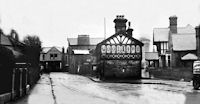 |
 The Boot Inn actually existed in Elizabethan times. It was reputed that it got it's name after a boot containing gold.which had been rescued from a robber by the landlord and returned to the rightful owner. Originally The Boot was a small white washed cottage, which stood on the rough road leading to Wallasey Village. This was knocked down and a two-storey building was erected in its place. The increase of traffic caused congestion so the local authority suggested road widening and so a new "Boot Inn" was built to the rear and in 1925 the old one was demolished. After renovation work the Boot Inn was renamed as 'The Turnberry' in 2004 but in 2008 was renamed back to its former name.
The Boot Inn actually existed in Elizabethan times. It was reputed that it got it's name after a boot containing gold.which had been rescued from a robber by the landlord and returned to the rightful owner. Originally The Boot was a small white washed cottage, which stood on the rough road leading to Wallasey Village. This was knocked down and a two-storey building was erected in its place. The increase of traffic caused congestion so the local authority suggested road widening and so a new "Boot Inn" was built to the rear and in 1925 the old one was demolished. After renovation work the Boot Inn was renamed as 'The Turnberry' in 2004 but in 2008 was renamed back to its former name.
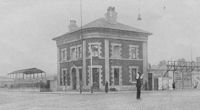 |
 There has always been a Wellington Hotel on the corner of Wallasey Road and Seaview Road since at least 1850 when the landlord was William Bird, who in 1860 was described as a cab proprietor. To supplement his income, he probably operated a horse and cab service linking Liscard with the ferries to Liverpool, and with Birkenhead via Poulton Bridge. A plot next to the Wellington Hotel on the Seaview Road side was purchased as the site for a replacement, the foundations of which were laid in June 1936. The new hotel was opened in 1937 and the old pub was demolished and the site is now part of Wallasey Road. Recently, after a refit in June 2008, the Wellington Hotel changed it's name to "Dukes" and advertises itself as a Bar & Grill.
There has always been a Wellington Hotel on the corner of Wallasey Road and Seaview Road since at least 1850 when the landlord was William Bird, who in 1860 was described as a cab proprietor. To supplement his income, he probably operated a horse and cab service linking Liscard with the ferries to Liverpool, and with Birkenhead via Poulton Bridge. A plot next to the Wellington Hotel on the Seaview Road side was purchased as the site for a replacement, the foundations of which were laid in June 1936. The new hotel was opened in 1937 and the old pub was demolished and the site is now part of Wallasey Road. Recently, after a refit in June 2008, the Wellington Hotel changed it's name to "Dukes" and advertises itself as a Bar & Grill.
 |
The old Queen's Arm's Pub was on the corner of Queen Street and Liscard Village. Attached to the old pub was a farm yard where cows were milked and housed. The Wallasey Commissioners. who were replaced by the Local Board of Health in 1852, held their first meeting at the Queen's in a room above the stables.
 |
 |
Before the building of The Capitol, Gibbon's Stables use to occupy the site. Established in 1860 it had a large yard, stables and carriage stables. They hired out horses and supplied them for the Fire Brigade. They were carriage proprietors and they were often hired for weddings and funerals. They were soon to move with the times and went over to motor vehicles. In the front of the forecourt were large iron gates which were kept closed and only opened to allow the cars to go in and out. As the years went by, the firm became part of the John W. Griffin and Son, the leading wedding and funeral directors in the town. The buildings were later demolished and The "Capitol" Picture House was built in its place and opened in September 1926. The cinema was able to seat 1,390 patrons and had a large balcony with a tiered form of seating. There was also an orchestra. After the cinema was modernised the Capitol became known as the 'A.B.C.Cinema' in 1959. As with most cinema's in Wallasey the Capitol closed in 1974 and was altered for the purpose of Bingo though this in turn closed in the 1990's and now the building lies unoccupied and boarded up with demolition work being carried out to the rear of the building.
Earlston House was originally a Manor house and dates back to the 15th Century and was once owned by Richard de Aston, Baron Of Halton. Robert and Thomas Aston also owned the Manor House before being sold to William Meols in 1609 for a sum of £160. In 1739 the house was sold to Charles Hough and family and, in 1752 was passed on to his son, John.
John Hough married the widow Magery Litherland in 1774 who already had two children. John was Lord of the Manor until his death in 1797 and is buried at St. Hilary's Church. In 1800 the house was put up for auction but was withdrawn when the offers all fell short of the asking price. It wasn't until a year later when John Penkett paid £2,513 for the Manor House and the surrounding land. He also purchased 'Stoney Hey', the windmill and 2 houses. John Penkett was born in 1752 and was a Liverpool merchant. He also held the post of Agent to the Powder Magazine in Liscard. He married Hannah Maddock and they had three children, William, Elizabeth and Mary Anne.
John Penkett also owned the large house "Seabank" which was situated near the river and once stood where Mariners Park stands today. Seabank Road takes its name from the house. It had been built by Sir John Tobin in the 1700s. John Penkett preferred to live near the river so he renamed the old Manor House as "Rose Mount" and became Lord Of The Manor Of Liscard at "Seabank" which in turn took the name "Liscard Manor House". "Seabank" had been originally built by Sir John Tobin in the 1700s.
When John Penkett died in 1838 "Rose Mount" was passed on to his daughter, Mary Ann, who then married her first cousin, John Maddock. In the 1850's the house was renamed "Earlston House". In 1880 Mary Ann donated the land around Earlston House, called 'Old Town Hey', to the local board. The plans were laid and in 1882 Rake Lane Cemetery and the Chapel opened.
After her death in 1888 "Earlston House" was bought by the local board. "Liscard Manor House" was purchased by the Trustees Of The Mariners' Home in 1925. The old building was eventually demolished in 1937 to make way for a new building.
In 1898 the Local Authority decided to have a Public Library under the Libraries Act. Four reading rooms were opened in 1899 in Poulton Hall, Earlston House, Brighton Street and in the Workmen's Hall in Wallasey Village.
In the early 20th Century a Scottish-American millionaire, Andrew Carneige donated £9,000 for the building of a new library next to Earlston House and named it 'Earlston Library'. On 30th September 1911 the new Reference Library was opened.
 The old house which got its name Liscard Castle stood where Castle Road and Turret Road are today on the top of Seaview Road. It was built in about 1810 and was once the home of John Astley Marsden. On account of the design of the house - it had several turrets which gave it a castle appearance - it became known as "Brush Castle". John Marsden was a brush manufacturer in Liverpool. It was also known as "Marsden Castle" or "Marsden Folly". The proper name of the house was "Marine
The old house which got its name Liscard Castle stood where Castle Road and Turret Road are today on the top of Seaview Road. It was built in about 1810 and was once the home of John Astley Marsden. On account of the design of the house - it had several turrets which gave it a castle appearance - it became known as "Brush Castle". John Marsden was a brush manufacturer in Liverpool. It was also known as "Marsden Castle" or "Marsden Folly". The proper name of the house was "Marine
Villa". Seaview Road in those days was called Marsden Lane, being named after him. Above the main bay-windows, high above between turrets was a stone lion. At a later date the castle was divided into three properties, 'The Castle', 'The Turrets', and 'The Towers'. As the years past the building fell into disrepair and the grounds became overgrown and so was demolished in 1902.
The Old Liscard Palace Picture House was once a popular cinema situated on Seaview Road.
 It was opened on the 25th November 1911 and was originally called 'Liscard Electric Palace'. It could hold 700 picture-goers in the auditorium and balcony.On the outside of the Palace were two shops on either side of the entrance. In 1920 the cinema was enlarged by extending the building and making the screen farther back. Further alterations were carried out in 1935 when curtains were draped and lit so that they slowly changed colour's while the patrons waited for the performance to commence. The front of the building, which was once decorated in plaster was rebuilt in rustic brick to give a more modern effect.
It was opened on the 25th November 1911 and was originally called 'Liscard Electric Palace'. It could hold 700 picture-goers in the auditorium and balcony.On the outside of the Palace were two shops on either side of the entrance. In 1920 the cinema was enlarged by extending the building and making the screen farther back. Further alterations were carried out in 1935 when curtains were draped and lit so that they slowly changed colour's while the patrons waited for the performance to commence. The front of the building, which was once decorated in plaster was rebuilt in rustic brick to give a more modern effect.
As with a majority of cinemas in Wallasey the Palace suffered from falling attendances and so closed in 1959. The building later became a supermarket - 'Lennon's' but now the 'Shoemarket' occupies the building.
 St. Alban's Church is the oldest Catholic Church in Wallasey. Before St Alban's was opened the Catholic community had to travel over to Liverpool for sunday morning mass. This was problematic for those on lower income so a Liverpool priest, Father Guest, took steps to remedy the situation and so set up a mission in Wallasey. The mission was initially set up in King Street above a public house called 'The Hens And The Chickens' (later renamed 'The Great Britain Hotel'). With growing numbers attending mass it was decided by the then priest, Father John Dawber, to open a Chapel School in St Alban's Road and it was opened on 8th September 1842.
St. Alban's Church is the oldest Catholic Church in Wallasey. Before St Alban's was opened the Catholic community had to travel over to Liverpool for sunday morning mass. This was problematic for those on lower income so a Liverpool priest, Father Guest, took steps to remedy the situation and so set up a mission in Wallasey. The mission was initially set up in King Street above a public house called 'The Hens And The Chickens' (later renamed 'The Great Britain Hotel'). With growing numbers attending mass it was decided by the then priest, Father John Dawber, to open a Chapel School in St Alban's Road and it was opened on 8th September 1842.
A decade later the first foundation stone was laid for the present church and on 18th September 1853 the Archbishop of Westminster, Cardinal Wiseman, preached the first sermon. Some alterations have been made to the church. In 1904 the spire had to be taken down and rebuilt. Between 1913/14 several structural defects were found in the building so a new Chancel arch and columns were built as well as new windows put in. The church then re-opened on 2nd August 1914.
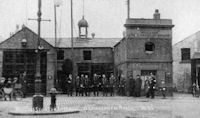 |
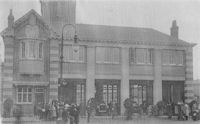 |
The first fire appliances were kept in front of the water tower in Mill Lane and up to 1900 Wallasey Fire Brigade was run by volunteers who were paid a small retainer. The old station, opened in 1898, was on part of the well known site in Manor Road and consisted of stabling and a yard.
The Fire Service improved, new, longer ladders and a manned fire engine, together with the latest hoses, were obtained.
In 1898 a fire occurred at the New Brighton Tower at which a fireman lost his life and, following this a steam fire-engine was purchased and a permanent Superintendent appointed. A chemical engine was acquired in 1900, and by 1910, when additional adjoining was purchased, there was a Superintendent, an engineer and six firemen.
By 1914 funding was provided for a new fire station which opened on the site on 23rd October 1915. The Fire Station continued to serve Wallasey until the early 1970s when the new station was built In Mill Lane in 1974. The old station was demolished and a car park now occupies the site.
 |
Manor Road School was built in 1903 to accommodate the growing population of Wallasey. It became Liscard Secondary in the 1950s and the Withensfield School in the 1960s. In the late 1970s Withensfield Middle School moved to the Grammar School site in Withens Lane and the old building was demolished for housing.
 |
St. Mary's Boys School opened in 1839 as the first elementary school in Liscard under the auspices of the National Society. The school building, which stands opposite the ambulance station on Liscard Road, was connected with St. John's Parish Church, until 1894. In the same year it was transferred to St. Mary's Church, and was thereafter known as St. Mary's School, until it closed shortly after the First World War. The building has been used for various reasons, including being part of Max Speilmann photographers. Today the site is being used by Wirral Metropolitan College.
 |
Egerton Grove comprised of three 16th Century cottages that stood on the corner of Egerton Grove and was opposite the General Post Office. It was a long and low thatched building made of sandstone and whitewashed. At some time the roof to the left-hand cottage had been changed to slate. The right hand cottage was particularly distinctive for the wide border of seashell decoration embedded in plaster around the end window opening. The cottages were demolished in 1924 and Hebron Hall was built on the site. Egerton Grove was so named for the large number of trees growing both sides of the little road.
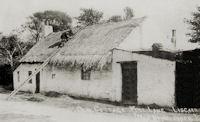 |
Keenan's Cottage once stood at what is now the junction of Dinmore Road. It was known as Keenan's Cottage, being named after Harry Keenan, b. 1817 in Ireland, who was the caretaker of the Mill Lane water tower that was opposite. As key holder he held an important position as the first fire appliances were kept at the front of the water tower, so he was called in an emergency. In 1881 he lived there with his wife Ellen, her brother William Doughty and her niece Mary Ellen Kay. In later years Mary Ellen married Peter Smith and may have been the 'Granny Smith' when the cottage was nicknamed Granny Smith's. The cottage was later demolished to make way for road widening.
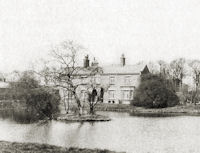 |
The Model Farm in Liscard was owned by Harold Littledale, the son-in-law of Sir John Tobin. He was a well-known merchant in Liverpool and created the farm as a sort of hobby, rather than a business.
The farm building stood in Mill Lane, while the farmhouse still stands in what is now Rullerton Road on the corner of Eldow Road. It dates from 1841 and had a small fine diamond-shaped panes of glass in the windows.
The farm had all the latest machinery for up-to-date farming, for threshing wheat, dividing and grinding. It could also crush animal foods as well as mix food and churn butter. The buildings were very well-ventilated, the dairy being constructed with double walls so as to exclude the hot weather in summer. The machinery was operated by a powerful steam engine. There was also a place for smoking hams.
Many farmers from far and wide came to see the Model Farm to study its methods and see the modern technology. The farm covered some 440 acres, as far as Wallasey Golf Links, as it is today, where the sheep were farmed. The Piggeries were near what is now Marlowe Road.
 |
There was a pond close to the farm off Mill Lane, where the farm labourer's lived in the small cottages. There was a small island in the middle of the pond with a few trees growing and covered in grass. The Bailiff had his own house by the cottages.
After Littledale's death in 1889, the estate was purchased by the Council and some of the land was transformed into parts of Central Park.
The Wallasey General Post Office opened in 1913 and was built on the site of the 'Trafford House' which was formally a Liscard Hall Farm.
'Dean's Terrace', Liscard Village, was built in 1782 and was three-storeys high. Only the end of the terrace still exists; that being 'The Royal Oak'.
The Concert Hall, Manor Road, was built in 1875 and was used for ballroom dancing. It was here in 1883 that Wallasey High School For Girls was born being founded by Canon Weatherhead and the Rector of St. Hilary's Church. Today the Concert Hall is the '27 Social Club'.
Y.M.C.A, Manor Road, was once a house called 'Homecroft' which was built in 1848 and was owned by the Pooley Family. On 21st August, 1899 it opened as the Y.M.C.A
_1973.jpg)
_Nov_1961 2.jpg)
_Nov_1961.jpg)
